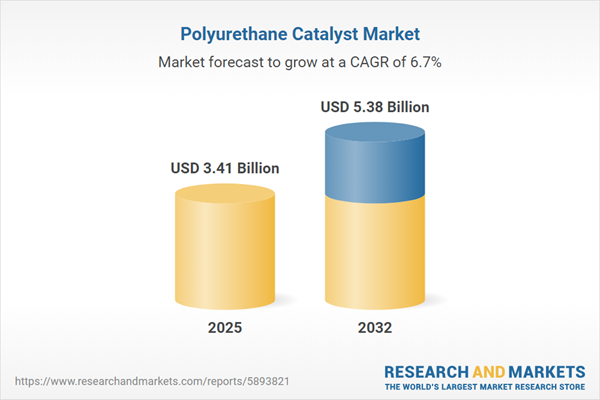Speak directly to the analyst to clarify any post sales queries you may have.
Senior executives in the chemical sector are managing notable changes as the polyurethane catalyst market adapts to new regulations, advances in catalyst technology, and evolving procurement strategies. The sector’s strategic emphasis now centers on sustainability, compliance, and robust supply chain models to address shifting market and regulatory requirements.
Market Snapshot: Global Polyurethane Catalyst Market Overview
The global polyurethane catalyst market is demonstrating stable growth, influenced by strong demand from core industries such as construction, automotive, and electronics. This trend is reinforced by ongoing use in both flexible and rigid polyurethane foam applications, as well as a rising need for tailored catalyst solutions. Market participants must address competitive dynamics shaped by tightening regulations, shifting technology standards, and diversified regional trade flows. Delivering sustainable innovation, maintaining compliance, and adapting quickly to market signals are now essential factors for remaining competitive in this evolving sector.
Scope & Segmentation of the Polyurethane Catalyst Market
This report provides a comprehensive analysis of the polyurethane catalyst market, with a focus on product innovation, end-use diversity, and strategic opportunities that arise from regional differences. Understanding these segments is vital for informed decision-making at all leadership levels:
- Type: Includes Amine Catalyst, Bismuth & Zinc Catalysts, Mercury Catalyst, Organo-Metallic Catalyst, and Tin Catalysts. Each varies in reactivity and emission control, supporting a broad range of polyurethane formulations and environmental objectives.
- Category: Consists of Blowing Catalyst, Crosslinking Catalysts, Curing Catalysts, Foam-Stabilization Catalyst, and Gelling Catalyst. These categories address critical factors such as curing time, manufacturing control, and finished product stability.
- Application: Covers Adhesives & Sealants, Coatings, Elastomers, Flexible Foam, and Foams. Selecting the correct catalyst type is essential for achieving factors like durable adhesion, desired elasticity, robust surface protection, and sponge-like cell uniformity.
- End-Use Industry: Spans Automotive, Construction, Electronics, Furniture & Bedding, Packaging, and Textiles. Sectors prioritize catalysts that meet specific durability, ergonomic, and environmental requirements for their applications.
- Geographical Coverage: Focuses on key regions, including the Americas, Europe, Middle East & Africa, and Asia-Pacific. Important markets such as the United States, Canada, Brazil, United Kingdom, Germany, China, India, and Japan each present unique regulatory and sourcing considerations.
- Company Profiles: Highlights major industry players such as Air Products and Chemicals, Inc., BASF SE, Covestro AG, DURA Chemicals, Inc., Evonik Industries AG, Huntsman International LLC, The Dow Chemical Company, and Umicore, all of whom shape global supply and innovation trends.
Key Takeaways for Senior Decision-Makers
- Ongoing development in catalyst chemistry is improving manufacturing accuracy, boosting performance metrics, and aligning with industry-specific needs for functional polyurethane products.
- Adoption of low-emission catalyst options, such as advanced amine, bismuth, and zinc formulations, is accelerating due to strengthened corporate sustainability and environmental policies.
- Evolving supply chains are prompting organizations to increase compliance, optimize for durability, and demonstrate measurable progress against environmental targets.
- Variations among regional regulations are encouraging localized innovation efforts, compelling firms to adjust sourcing and adapt product portfolios to meet differing market expectations.
- Digitalization is enhancing operational efficiency and facilitating the development of bespoke catalyst solutions, often in cooperation with technology partners or value chain participants.
Tariff Impact: Navigating Supply Chain Adjustments
Recent modifications to tariffs on raw materials and imported catalysts, particularly within U.S. borders, have directly influenced production costs and supplier relationships. In response, manufacturers are seeking resilience by locking in longer-term agreements, broadening procurement networks across multiple territories, and strengthening inventory controls. These strategies are reshaping global trading flows and supporting greater adaptability within the polyurethane catalyst supply chain.
Methodology & Data Sources
The research adopts a multifaceted approach, combining thorough secondary data analysis with targeted interviews of sector stakeholders and triangulation of multiple primary data streams. Inputs were validated through regulatory reviews, patent analyses, and engagement with R&D and supply chain decision-makers, with final insights confirmed by expert panels for reliability and strategic value.
Why This Report Matters for Polyurethane Catalyst Stakeholders
- Presents actionable segmentation and competitor insights critical for developing targeted polyurethane catalyst products and ensuring regulatory adherence in key markets.
- Enables senior leaders to identify and capitalize on emerging opportunities, benchmark competitors, and effectively manage transition risks within evolving procurement and policy landscapes.
- Promotes more accurate planning and collaborative decision-making through tailored market intelligence specifically designed for the catalyst sector.
Conclusion
Continuous adaptation to sustainability imperatives, emerging regulations, and new supply models is essential for leadership within the polyurethane catalyst industry. This report equips senior executives with the insight required to shape responsive, future-ready strategies as market dynamics continue to evolve.
Additional Product Information:
- Purchase of this report includes 1 year online access with quarterly updates.
- This report can be updated on request. Please contact our Customer Experience team using the Ask a Question widget on our website.
Table of Contents
3. Executive Summary
4. Market Overview
7. Cumulative Impact of Artificial Intelligence 2025
Samples

LOADING...
Companies Mentioned
The key companies profiled in this Polyurethane Catalyst market report include:- Air Products and Chemicals, Inc.
- Alfa Chemicals
- BASF SE
- Biesterfeld AG
- Covestro AG
- DURA Chemicals, Inc.
- Evonik Industries AG
- Gulbrandsen
- Huntsman International LLC
- Kao Corporation
- Lanxess AG
- MAPEI S.p.A.
- Merck KGaA
- Mitsui Chemicals, Inc.
- Momentive Performance Materials Inc.
- PATCHAM
- SEHOTECH Inc.
- Shanghai Dimonds Chemical Technology Co., Ltd.
- Sinocure Chemical Group Co.,Limited
- Solvay S.A.
- The Chemours Company
- The Dow Chemical Company
- Tokyo Chemical Industry Co., Ltd.
- Tosoh Europe B.V.
- Umicore
Table Information
| Report Attribute | Details |
|---|---|
| No. of Pages | 193 |
| Published | October 2025 |
| Forecast Period | 2025 - 2032 |
| Estimated Market Value ( USD | $ 3.41 Billion |
| Forecasted Market Value ( USD | $ 5.38 Billion |
| Compound Annual Growth Rate | 6.6% |
| Regions Covered | Global |
| No. of Companies Mentioned | 26 |









